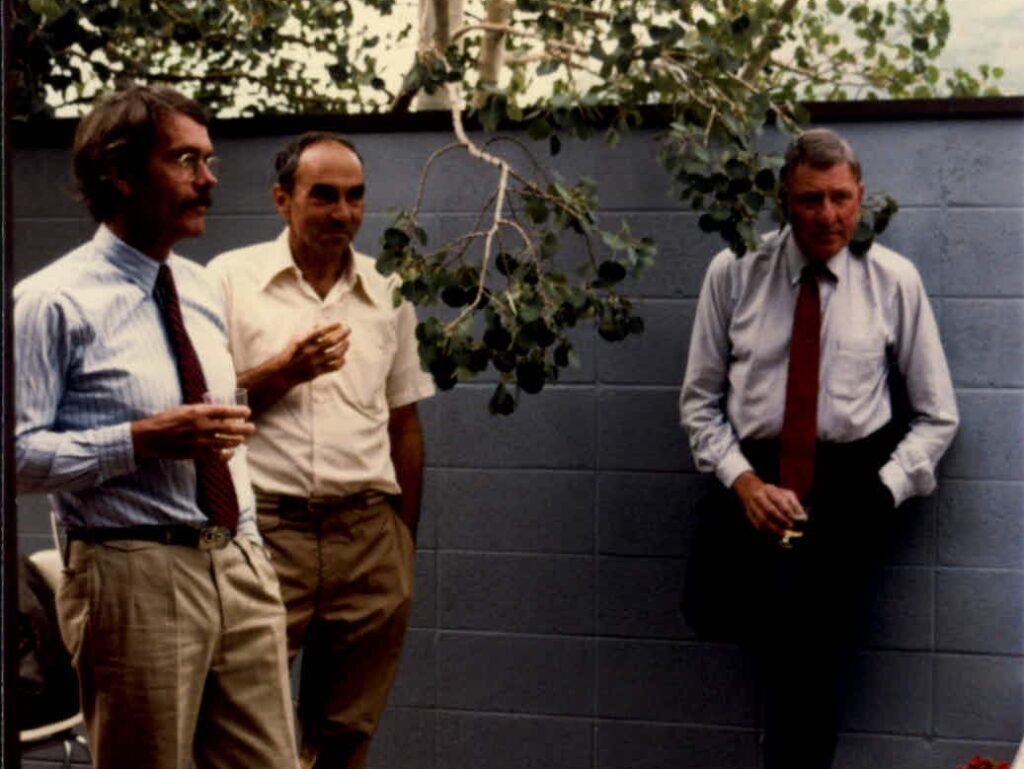Surely you were joking, Mr. Cohen. The notion of a bunch of physicists living in tents and exchanging thoughts when not fending off bears is ridiculous. (More so than seven curled-up dimensions?) In retrospect, my concept of a tent city was a metaphor for the idea of a group of physicists doing their own thing in a beautiful rural environment. My wife and I actually took a serious look at Tolland, Colorado, an abandoned town at the entrance to the Moffat Tunnel, where the California Zephyr passed under the Rockies. John Toll, a well-known physicist whose ancestors founded the town, would have let us camp there, and it is unlikely that we would ever have had to sort through 1,000 applications.
In most of the many Universes, the values of the fundamental constants are such that Michel Baranger would not have put me in touch with George Stranahan, and Stranahan would not have been engaged in discussions with Bob Craig about bringing physics to Aspen. Nor would our institution have survived and thrived without the efforts and generosity of physicists and friends whom I dare not try to enumerate. Summer salaries, funded by grants, were a relatively new phenomenon in 1962, and it was generally assumed that the recipient of the grant would remain at his (there were not many hers) home institution while receiving the summer salary. The basic idea underlying my tent city concept was not the tents, but rather the belief that a theorist (and some experimentalists) could be equally or more productive away from home if the environment included other physicists – so why shouldn’t a summer salary be portable? And we hoped to make our Aspen operation affordable for participants without summer salaries.
Fortunately, the National Science Foundation accepted the portability principle, at least on a trial basis. However, a number of years elapsed before the NSF gave us a direct institutional grant to cover secretarial salaries, maintenance of the property, etc. The rumor mill told me that the NSF had expected us to die a natural death, but it finally became obvious that a lot of productive interaction was occurring at the Physics Division of the Aspen Institute, which evolved into the independent Aspen Center for Physics. I think one of Stranahan’s children invented the name.
Most universities did not object to the physicists’ carrying their salaries to Aspen, as long as the overhead stayed at home. If we could have had some of the overhead, there would have been no financial problems. In the hope that to see us was to love us and fund us, we repeatedly invited an NSF operative (call him G) to visit Aspen.
On a warm afternoon in July 1963, our secretary, Marcy, told Stranahan that G had just called from Denver Airport and would be arriving in Aspen in an hour, and wanted to meet with Stranahan and Cohen. An anomalous number of physicists were AWOL that afternoon, including Cohen. I was halfway up a rock face nine miles east of Aspen, being auditioned by David Michael, an experienced local climber, to see whether I was sufficiently competent to join him and George Bell in an attempt on the great northwest face of Capitol Peak. Bell, a Los Alamos physicist, had been with Bob Craig during the remarkable 1953 American attempt on K2. But I digress. G was coming and we weren’t ready.
Stranahan, trying to do some damage control, jumped into his Jeep and raced up the Independence Pass road. Luckily he spotted David and me. We hastily rappelled, and I raced back to town with George. Arriving at the Physics Building, we were informed that G had been diverted to Sidney Bludman’s house, to which we proceeded. Arriving at Bludman’s, we found Sidney and Dan Fivel, the perpetrator of this fiendish practical joke, cowering in fear and offering martinis to us as pacifiers.
Our ascent of Capitol went quite smoothly (American Alpine Journal 1964, p.194). As we neared the summit, R.O. Anderson’s twin prop plane circled beneath us and waggled its wings. Our route (we were unaware of any previous ascent of that line) is now one of the easiest routes on that face.
During the first few years, before we incorporated, the administrative structure of the Physics Division was remarkably informal. When something had to be done, someone did it. I don’t remember electing officers; who would have voted? With a physicist’s contempt for standard accounting procedure, I invented a totally rational and simple bookkeeping system, based on two ledgers. Sooner or later, some auditor undoubtedly destroyed my creation.
Randy Durand later summarized our modus operandi: we were all very young and improvised as the need arose. Housing often created unexpected problems, though we were lucky to have Sally Mencimer as Enforcer. Nevertheless, our whole organization, including Sally, was stymied by the very stubborn wife of a mild-mannered physicist, who refused to move out of their condo on the appointed day. The wife was mad at us because we hadn’t given them an extra bedroom for her mother, and said, “You have created an inconvenience for me. Now I will create an inconvenience for you.” Somehow we solved that problem without tear gas. One physicist suggested that our announcement should clearly state that our housing policy is extremely non-relativistic:
No Extra Bedrooms for Relatives.*
*This is a riff on Sam Goldwyn’s statement that he had explained his Theory of Relativity to Einstein: Never hire relatives.



